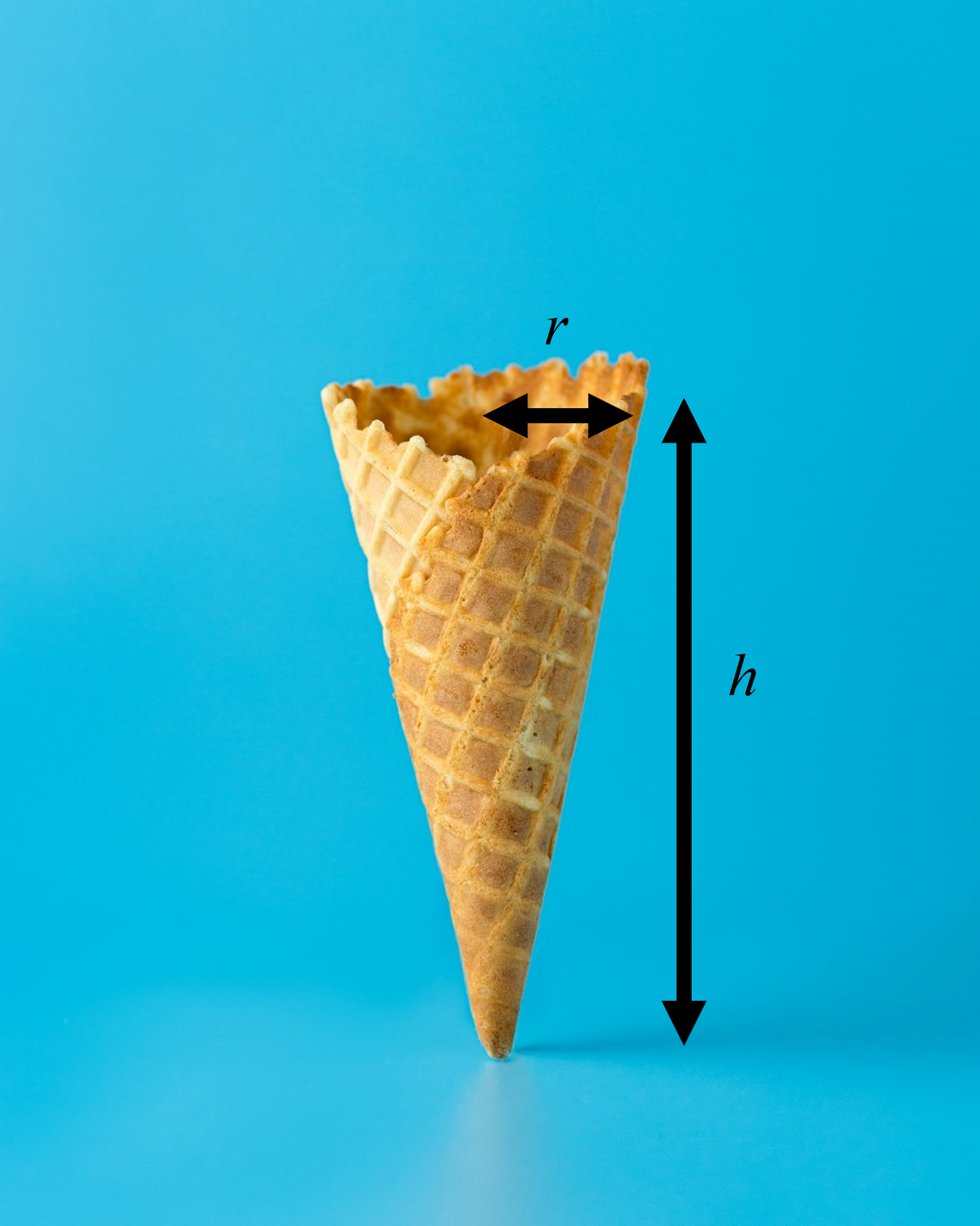# Matplotlib compatibility patch for Pyodide
import matplotlib
if not hasattr(matplotlib.RcParams, "_get"):
matplotlib.RcParams._get = dict.get
Class exercise: Ice cream cone#
Added in version v2024.3.0: After class March 10th
Solutions in text and downloads

Fig. 11 ice cone#
We want to minimize the surface area of a cone, while not making the gap on the top too big (in terms of area). Let’s define this as a multi-objective optimization problem with
the first objective to minimize the ice cream cone area \(\pi r \sqrt{r^2+h^2}\)
the second objective to minimize the ice cream cone area + the area of the gap \(\pi r \sqrt{r^2+h^2} + \pi r^2\).
The total volume inside the cone must be at least 200.
Find the pareto front using normalized objective functions
Exercise 39 (Model)
Write out the model of this problem.
Solution to Exercise 39 (Model)
The minimum and maximum \(Area\) and \(Gap\) could be find by solving two single-objective problems:
import scipy as sp
import numpy as np
def Area(x):
return np.pi* x[0] * np.sqrt(x[0]**2 + x[1]**2)
def Total(x):
return np.pi* x[0] * np.sqrt(x[0]**2 + x[1]**2) + 4/3 * np.pi*x[0]**2
x0 = np.array([5,10])
def nonlinconfun(x):
c = np.pi / 3 * x[0]**2 * x[1]
return c
cons = sp.optimize.NonlinearConstraint(nonlinconfun, 200, np.inf)
bounds = [[0, np.inf],
[0, np.inf]]
result = sp.optimize.minimize(fun = Area, x0 = x0, bounds = bounds, constraints = cons)
print(result)
print(Area(result.x))
print(Total(result.x))
message: Optimization terminated successfully
success: True
status: 0
fun: 143.23025086897755
x: [ 5.131e+00 7.256e+00]
nit: 6
jac: [ 3.722e+01 1.316e+01]
nfev: 18
njev: 6
143.23025086897755
253.48896806009228
result = sp.optimize.minimize(fun = Total, x0 = x0, bounds = bounds, constraints = cons)
print(result)
print(Area(result.x))
print(Total(result.x))
message: Optimization terminated successfully
success: True
status: 0
fun: 224.73872628150949
x: [ 3.840e+00 1.296e+01]
nit: 10
jac: [ 7.804e+01 1.157e+01]
nfev: 27
njev: 9
162.98691601464716
224.73872628150949
Leading to:
\(\min_{r,h} Area\left(r,h\right) \approx 143 \)
\(\max_{r,h} Area\left(r,h\right) \approx 162 \)
\(\min_{r,h} Total\left(r,h\right) \approx 224 \)
\(\max_{r,h} Total\left(r,h\right) \approx 253 \)
Exercise 40 (Method)
Now let’s solve this problem using an optimization method.
Click –> Live Code to activate live coding on this page!
import scipy as sp
import numpy as np
#YOUR CODE HERE
Solution to Exercise 40 (Method)
def weighted_obj_pareto(x):
return delta_Area * ( Area(x) -143) / ( 162 - 143) + delta_Total * ( Total(x) - 224) / ( 253 - 224)
%%time
x_pareto_opt =[]
delta_Area_list = np.linspace(0,1,101)
delta_Area_opt = []
delta_Total_list = 1 - delta_Area_list
delta_Total_opt = []
for i in range(101):
delta_Area = delta_Area_list[i]
delta_Total = delta_Total_list[i]
result_i = sp.optimize.minimize(fun = weighted_obj_pareto,x0=x0,bounds=bounds, constraints = cons)
if result_i.success:
x_pareto_opt.append(result_i.x)
delta_Area_opt.append(delta_Area)
delta_Total_opt.append(delta_Total)
else:
print(result_i.message)
CPU times: total: 234 ms
Wall time: 227 ms
import matplotlib.pyplot as plt
%config InlineBackend.figure_formats = ['svg']
Area_pareto_opt = []
Total_pareto_opt = []
for i in range(len(x_pareto_opt)):
Area_pareto_opt.append(Area(x_pareto_opt[i]))
Total_pareto_opt.append(Total(x_pareto_opt[i]))
plt.figure()
plt.plot(Area_pareto_opt,Total_pareto_opt,'x')
for i in range(len(x_pareto_opt)):
if i%10 == 0:
plt.annotate(f"($\delta_S,\delta_T$)=({round(delta_Area_opt[i],1)},{round(delta_Total_opt[i],1)})", (Area_pareto_opt[i], Total_pareto_opt[i]), ha='left',va = 'bottom',rotation=30)
plt.xlabel('Lateral surface area (m$^2$)')
plt.ylabel('Total surface area (m$^2$)')
plt.title('Pareto Front')
ax = plt.gca()
ax.spines['right'].set_color('none')
ax.spines['top'].set_color('none')
